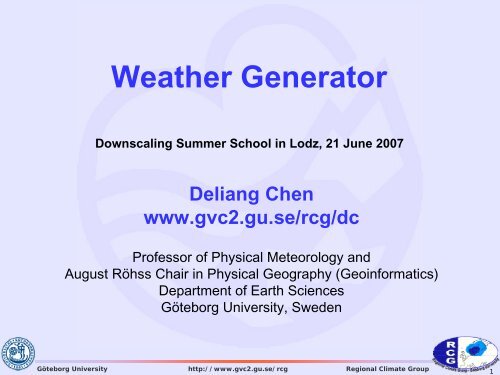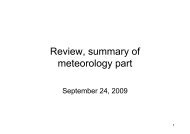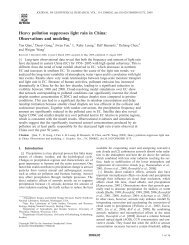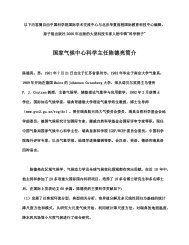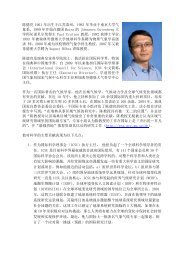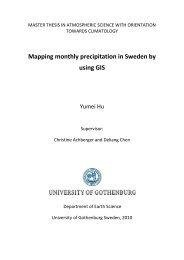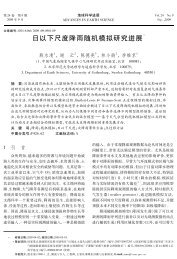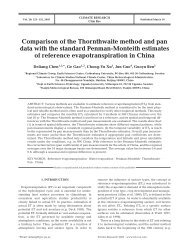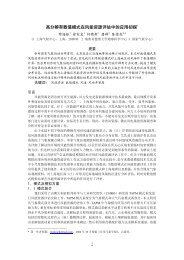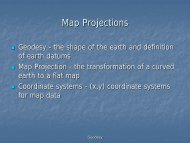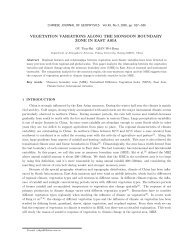t - Regional Climate Group
t - Regional Climate Group
t - Regional Climate Group
- No tags were found...
You also want an ePaper? Increase the reach of your titles
YUMPU automatically turns print PDFs into web optimized ePapers that Google loves.
Weather Generator<br />
Downscaling Summer School in Lodz, 21 June 2007<br />
Deliang Chen<br />
www.gvc2.gu.se/rcg/dc<br />
Professor of Physical Meteorology and<br />
August Röhss Chair in Physical Geography (Geoinformatics)<br />
Department of Earth Sciences<br />
Göteborg University, Sweden<br />
Göteborg University http://www.gvc2.gu.se/rcg <strong>Regional</strong> <strong>Climate</strong> <strong>Group</strong><br />
1
Topics covered<br />
• Statistical downscaling: Techniques<br />
and methodologies<br />
• What is a Weather Generator (WG)<br />
• Two types of WG<br />
• How WG is used in downscaling<br />
• Suggested further readings<br />
Göteborg University http://www.gvc2.gu.se/rcg <strong>Regional</strong> <strong>Climate</strong> <strong>Group</strong><br />
2
Acknowledgement<br />
• Some of the OHs appeared in my<br />
lectures are adopted from<br />
CCIS, Dr. Pierluigi Calanca and<br />
Dr. Rob Wilby.<br />
Göteborg University http://www.gvc2.gu.se/rcg <strong>Regional</strong> <strong>Climate</strong> <strong>Group</strong><br />
3
Temporal and spatial scales<br />
of climate<br />
(Global<br />
climate<br />
model)<br />
GCM<br />
RCM<br />
(<strong>Regional</strong><br />
climate<br />
model)<br />
Göteborg University http://www.gvc2.gu.se/rcg <strong>Regional</strong> <strong>Climate</strong> <strong>Group</strong><br />
4
How to build the statistical model<br />
• Transfer functions: quantify relationship between large-scale<br />
climate (predictor) and local variables (predictand) by<br />
e.g. regression. Most often used for monthly temperature and<br />
precipitation.<br />
Related to Perfect Prognosis (PP) and Model Output Statistic<br />
(MOS) in numerical weather prediction.<br />
• Weather typing: relate a particular atmospheric state<br />
to a set of local climate variables<br />
(Lamb weather typing, Grosswetterlagen, others..)<br />
• Weather generators: generate realistic looking sequences<br />
of e.g. daily precipitation based on the large-scale<br />
atmospheric state<br />
Göteborg University http://www.gvc2.gu.se/rcg <strong>Regional</strong> <strong>Climate</strong> <strong>Group</strong><br />
5
Statistical downscaling: methods<br />
• linear – in large majority of studies<br />
– regression<br />
– canonical correlation / covariance (SVD)<br />
analysis<br />
• nonlinear<br />
– neural networks<br />
– analog<br />
Göteborg University http://www.gvc2.gu.se/rcg <strong>Regional</strong> <strong>Climate</strong> <strong>Group</strong><br />
6
Statistical downscaling:<br />
Reproduction of variance<br />
• underestimated variance in downscaled data<br />
• two ways of reproduction of variance<br />
– inflation (enhancement of anomalies by a<br />
constant factor)<br />
• physically questionable all forcing comes<br />
from large-scales<br />
– adding noise<br />
• white noise<br />
• regression residuals<br />
• noise with pre-specified statistical<br />
characteristics<br />
Göteborg University http://www.gvc2.gu.se/rcg <strong>Regional</strong> <strong>Climate</strong> <strong>Group</strong><br />
7
Statistical downscaling:<br />
reproduction of variance<br />
observed<br />
downscaled: stddev = 58% obs<br />
downscaled inflated<br />
Göteborg University http://www.gvc2.gu.se/rcg <strong>Regional</strong> <strong>Climate</strong> <strong>Group</strong><br />
8
Statistical downscaling:<br />
Reproduction of variance<br />
observed<br />
downscaled: stddev = 58% obs<br />
white noise<br />
downscaled with added white noise<br />
Göteborg University http://www.gvc2.gu.se/rcg <strong>Regional</strong> <strong>Climate</strong> <strong>Group</strong><br />
9
Statististical downscaling:<br />
Reproduction of variance<br />
obs down infl<br />
added<br />
white n.<br />
correlation<br />
with OBS<br />
1.000 0.826 0.826 0.598<br />
autocorrel. 0.587 0.619 0.619 0.305<br />
Göteborg University http://www.gvc2.gu.se/rcg <strong>Regional</strong> <strong>Climate</strong> <strong>Group</strong><br />
10
A successful statistical<br />
downscaling requires<br />
•A strong statistical relationship between local and<br />
large scale climate variables be established;<br />
•The statistical relationship should be physically<br />
interpretable and temporally stationary;<br />
•The large scale variables must be those that can be<br />
reliably produced by GCM;<br />
•Attempts should be made to understand the<br />
unexplained part by the statistical model and to<br />
assess/compensate its effect if possible.<br />
Göteborg University http://www.gvc2.gu.se/rcg <strong>Regional</strong> <strong>Climate</strong> <strong>Group</strong><br />
11
Added value of downscalings (SD,DD)<br />
120<br />
100<br />
80<br />
Hellstroem et al., 2001<br />
Vänersborg, One station in southern Sweden<br />
obs<br />
SDE<br />
DDE<br />
ECHA<br />
Precipitation (mm/month)<br />
60<br />
40<br />
20<br />
120<br />
100<br />
80<br />
1 2 3 4 5 6 7 8 9 10 11 12<br />
obs<br />
SDH<br />
DDH<br />
HadC<br />
60<br />
40<br />
20<br />
1 2 3 4 5 6 7 8 9 10 11 12<br />
Month<br />
Göteborg University http://www.gvc2.gu.se/rcg <strong>Regional</strong> <strong>Climate</strong> <strong>Group</strong><br />
b<br />
12
Differences between<br />
real world and GCM-world<br />
Göteborg University http://www.gvc2.gu.se/rcg <strong>Regional</strong> <strong>Climate</strong> <strong>Group</strong><br />
13
Two extremes to categories of downscaling:<br />
• Transfer functions relating atmospheric forcing to target<br />
variable<br />
• Stochastic functions and pure weather generators<br />
For both: variance explained as a function of the large scale flow, residual<br />
variance can only be stochastically generated.<br />
For future climate, only change due to the signal contained in the GCM<br />
scale forcing can be accounted for …..<br />
Variance explained<br />
Synoptic Forcing<br />
Sub-grid scale forcings<br />
Synoptic scale<br />
Local scale<br />
Göteborg University http://www.gvc2.gu.se/rcg <strong>Regional</strong> <strong>Climate</strong> <strong>Group</strong><br />
14
Transfer Functions<br />
Area<br />
Grid Box<br />
Select<br />
predictor<br />
variables<br />
Calibrate<br />
and verify<br />
model<br />
Predictor variables<br />
e.g., MSLP, 500, 700 hPa geopotential heights,<br />
zonal/meridional components of flow, areal T&P<br />
Transfer function<br />
e.g., Multiple linear regression, principal<br />
components analysis, canonical correlation<br />
analysis, artificial neural networks<br />
Extract<br />
predictor<br />
variables<br />
from GCM<br />
output<br />
Drive<br />
model<br />
Observed station data for<br />
predictand<br />
Site variables for<br />
future, e.g., 2050<br />
Göteborg University http://www.gvc2.gu.se/rcg <strong>Regional</strong> <strong>Climate</strong> <strong>Group</strong><br />
15
Weather Typing<br />
Identify<br />
weather<br />
types<br />
Derive<br />
Observed<br />
weather<br />
variables<br />
Select<br />
classification<br />
scheme<br />
Relationships between<br />
weather type and local<br />
weather variables<br />
Pressure fields<br />
from GCM<br />
Calculate<br />
weather<br />
types<br />
Drive<br />
model<br />
Local weather<br />
variables for,<br />
say, 2050<br />
Statistically relate<br />
observed station or<br />
area-average<br />
meteorological data to<br />
a weather<br />
classification scheme.<br />
Weather classes may<br />
be defined objectively<br />
(e.g. by PCA, neural<br />
networks) or<br />
subjectively derived<br />
(e.g., Lamb weather<br />
types [UK], European<br />
Grosswetterlagen)<br />
Göteborg University http://www.gvc2.gu.se/rcg <strong>Regional</strong> <strong>Climate</strong> <strong>Group</strong><br />
16
Weather Typing<br />
Fundamental Assumption<br />
the relationships between weather type and local<br />
climate variables will continue to be valid under<br />
future radiative forcing<br />
ADVANTAGES<br />
• founded on sensible physical linkages between<br />
climate on the large scale and weather on the local<br />
scale<br />
Göteborg University http://www.gvc2.gu.se/rcg <strong>Regional</strong> <strong>Climate</strong> <strong>Group</strong><br />
17
Example: Investigate the link between circulation and<br />
winter temp. (1)<br />
(Chen, 2000: A monthly circulation climatotolgy for Sweden and its application to a winter<br />
temperature case study. Int. journal of Climatology 20, 1067-1076<br />
Approach: transfer function (multiple regression)<br />
Predictant=f(predictors)<br />
winter temp.<br />
circulation<br />
(strength of geostrophic flow<br />
and vorticity)<br />
T a =-3.48+0.079v+0.32V+0.17ξ<br />
circulation indices<br />
Göteborg University http://www.gvc2.gu.se/rcg <strong>Regional</strong> <strong>Climate</strong> <strong>Group</strong><br />
18
Example 1: cont……<br />
How to quantify of atmospheric circulation<br />
Circulation indices and weather typing based on the system by Lamb<br />
ξ<br />
6 circulation indices:<br />
U<br />
V<br />
u: west-east geostr. wind<br />
v: north-south geostr. wind<br />
W: total geostr. wind<br />
ξ u<br />
: westerly shear vorticity<br />
ξ v<br />
: southerly shear vorticity<br />
ξ: total vorticity<br />
(after Chen and Li, 2003)<br />
Göteborg University http://www.gvc2.gu.se/rcg <strong>Regional</strong> <strong>Climate</strong> <strong>Group</strong><br />
19
Example 1: cont……<br />
Temperature anomaly ( o C)<br />
7<br />
6<br />
5<br />
4<br />
3<br />
2<br />
1<br />
0<br />
-1<br />
-2<br />
-3<br />
-4<br />
-5<br />
-6<br />
-7<br />
-8<br />
January temperature in SW Sweden<br />
R=0.84<br />
N=122<br />
observation<br />
reconstruction<br />
-9<br />
1870 1880 1890 1900 1910 1920 1930 1940 1950 1960 1970 1980 1990 2000<br />
Year<br />
Chen, 2000<br />
Göteborg University http://www.gvc2.gu.se/rcg <strong>Regional</strong> <strong>Climate</strong> <strong>Group</strong><br />
20
General categories of methodologies<br />
Transfer Weather Stochastic conditioned Stochastic<br />
Function Typing on weather type<br />
Stochastic / weather generators calibrated on observed<br />
data, conditioned on atmospheric state.<br />
• Very effective at capturing high frequency variance,<br />
peaks and extremes<br />
• Requires long term data sets to effectively define<br />
stochastic characteristics<br />
• Question of stationarity<br />
Göteborg University http://www.gvc2.gu.se/rcg <strong>Regional</strong> <strong>Climate</strong> <strong>Group</strong><br />
21
What is a WG<br />
WG is a and stochastic (based<br />
on observed probability)<br />
model of meteorological<br />
variables. It can generate<br />
unlimited length of data.<br />
Göteborg University http://www.gvc2.gu.se/rcg <strong>Regional</strong> <strong>Climate</strong> <strong>Group</strong><br />
22
The key problem->why WG<br />
Output of GCM<br />
~ 300 km<br />
~ 1 mo<br />
Ecosystem and other<br />
Impact models<br />
~ 1-10 km<br />
~ 1 h-1 day<br />
⇒ Disparity of spatial (and temporal) scales<br />
Göteborg University http://www.gvc2.gu.se/rcg <strong>Regional</strong> <strong>Climate</strong> <strong>Group</strong><br />
23
Stochastic weather generators:<br />
basic idea<br />
given slow set of statistics (monthly means and<br />
standard deviations, Y, from downscaling),<br />
generate the high frequency variability of the<br />
weather (y) assuming auto- and cross correlation:<br />
⇒ y(t) = O T [Y, y(t-1)]<br />
where O T is the time operator.<br />
Göteborg University http://www.gvc2.gu.se/rcg <strong>Regional</strong> <strong>Climate</strong> <strong>Group</strong><br />
24
Matching the scales:<br />
two common approaches<br />
(i) nesting <strong>Regional</strong> <strong>Climate</strong> Models (RCMs,<br />
horizontal resolution Δx < 10 km) into GCMs.<br />
Advantage: mathematical description of system is<br />
basically preserved!<br />
However: CPU ~ 1/(Δx) 2 or even 1/(Δx) 3<br />
⇒ Running a RCM at Δx ~ 1 km requires<br />
10 4 to 10 6 as much CPU as at Δx ~ 100 km!<br />
Göteborg University http://www.gvc2.gu.se/rcg <strong>Regional</strong> <strong>Climate</strong> <strong>Group</strong><br />
25
(ii) Statistical downscaling (space dimension) at<br />
low temporal resolution (say Δt ~ 1 mo),<br />
followed by stochastic generation of weather<br />
sequences (time dimension) at a fixed location.<br />
Advantage: computationally efficient<br />
⇒ large number of simulations feasible!<br />
Göteborg University http://www.gvc2.gu.se/rcg <strong>Regional</strong> <strong>Climate</strong> <strong>Group</strong><br />
26
Key publications in the development of daily WG<br />
Site(s) Observation Source<br />
Brussels Wet and dry days tend to cluster Quetelet (1852)<br />
Kew, Aberdeen,<br />
Greenwich, Valencia<br />
Probability of a rain day is greater if the<br />
previous day was wet<br />
Rothamstead, UK; Wet and dry spell lengths have a geometric<br />
five Canadian cities distribution<br />
Tel Aviv<br />
Use of Markov chain to reproduce geometric<br />
distribution of wet and dry spell lengths<br />
Combined Markov occurrence model with<br />
exponential distribution for rainfall amounts<br />
USA<br />
Generation of max/min temperature, and<br />
solar radiation conditional on rain occurrence<br />
USA<br />
Multi-site generalization of daily stochastic<br />
precipitation model<br />
Newnham (1916);<br />
Besson (1924); Gold<br />
(1929); Cochran<br />
(1938)<br />
Williams (1952);<br />
Longley (1953)<br />
Gabriel and<br />
Neumann (1962)<br />
Todorovic and<br />
Woolhiser (1975)<br />
Richardson (1981)<br />
Bras and Rodriguez-<br />
Iturbe (1976)<br />
Source: Wilby<br />
Göteborg University http://www.gvc2.gu.se/rcg <strong>Regional</strong> <strong>Climate</strong> <strong>Group</strong><br />
27
Precipitation occurrence process<br />
Most weather generators contain separate treatments of the<br />
precipitation occurrence and intensity processes.<br />
A first-order Markov chain for precipitation occurrence is fully<br />
defined by two conditional probabilities<br />
and<br />
p 01 = Pr{precipitation on day t | no precipitation on day t-1}<br />
p 11 = Pr{precipitation on day t | precipitation on day t-1}<br />
which are called transition probabilities.<br />
Göteborg University http://www.gvc2.gu.se/rcg <strong>Regional</strong> <strong>Climate</strong> <strong>Group</strong><br />
28
Precipitation occurrence processes (cont.)<br />
The transition probabilities for Cambridge, UK are as follows<br />
dry-to-wet (p 01 ) = 0.291<br />
wet-to-wet (p 11 ) = 0.654<br />
Therefore it follows (for a two state model) that<br />
dry-to-dry (p 00 ) = 1 - p 01 = 0.709<br />
wet-to-dry (p 10 ) = 1 - p 11 = 0.346<br />
This approach may be extended from a first-order to n th -order model<br />
by considering transitions that depend on states on days t-1, t-2…...t-n<br />
(as in Gregory et al., 1993).<br />
Göteborg University http://www.gvc2.gu.se/rcg <strong>Regional</strong> <strong>Climate</strong> <strong>Group</strong><br />
29
Precipitation amount processes<br />
Daily precipitation amounts are typically strongly skewed to the right.<br />
The simplest reasonable model is the exponential distribution, as it<br />
requires specification of only one parameter, μ, and whose probability<br />
density function is:<br />
f(x)<br />
=<br />
1<br />
μ<br />
⎡− x<br />
exp⎢<br />
⎣ μ<br />
The two-parameter gamma distribution is another popular choice,<br />
defined by the shape α and scale parameter β:<br />
f(x)<br />
=<br />
⎤<br />
⎥<br />
⎦<br />
α-1<br />
( ) [ ]<br />
x<br />
β<br />
exp -<br />
βΓ( α)<br />
x<br />
β<br />
Most weather generators make the assumption that precipitation amounts on<br />
successive wet days are independent.<br />
Göteborg University http://www.gvc2.gu.se/rcg <strong>Regional</strong> <strong>Climate</strong> <strong>Group</strong><br />
30
Precipitation amount processes (cont.)<br />
January precipitation at<br />
Ithaca, New York 1900-<br />
1998 represented by<br />
three pdfs:<br />
• exponential<br />
•gamma<br />
• mixed exponential<br />
Source: Wilks and Wilby (1999)<br />
Göteborg University http://www.gvc2.gu.se/rcg <strong>Regional</strong> <strong>Climate</strong> <strong>Group</strong><br />
31
Daily total (mm)<br />
140<br />
120<br />
100<br />
80<br />
60<br />
40<br />
Precipitation and its PDF<br />
[1] raw data<br />
20<br />
0<br />
0.4<br />
0.35<br />
0.3<br />
0.25<br />
0.2<br />
[2] empirical pdf<br />
0.15<br />
0.1<br />
0.05<br />
0<br />
0 10 20 30 40 50<br />
Daily to tal (mm)<br />
Göteborg University http://www.gvc2.gu.se/rcg <strong>Regional</strong> <strong>Climate</strong> <strong>Group</strong><br />
32
Other meteorological variables<br />
Condition the statistics of the daily variables (typically maximum/<br />
minimum temperatures and solar radiation) on occurrence of<br />
precipitation (a proxy for other processes such as cloud cover).<br />
In the classic WGEN model, multiple variables are modelled<br />
simultaneously with auto-regression:<br />
z<br />
() [ ] ( ) [ ] ()<br />
t<br />
=<br />
A z<br />
t<br />
- 1<br />
+<br />
Where z(t) are normally distributed values for today’s nonprecipitation<br />
variables, z(t-1) are corresponding values for the previous day, and [A]<br />
and [B] are K × K matrices of parameters, and ε(t) is white-noise forcing.<br />
B<br />
ε<br />
t<br />
Göteborg University http://www.gvc2.gu.se/rcg <strong>Regional</strong> <strong>Climate</strong> <strong>Group</strong><br />
33
Other meteorological variables (cont.)<br />
The z(t) are transformed to weather variables dependent on rainfall<br />
occurrence:<br />
T<br />
k<br />
() t<br />
= {<br />
μ<br />
μ<br />
k,0<br />
k,1<br />
+ σ<br />
+ σ<br />
k,0<br />
k,1<br />
() t z () t<br />
k<br />
() t z () t<br />
k<br />
if day t is dry<br />
if day t is wet<br />
where each T k is any of the nonprecipitation variables, μ k,0 and σ k,0<br />
are its mean and standard deviation for dry days, and μ k,1 and σ k,1<br />
are its mean and standard deviation for wet days.<br />
Seasonal dependence of the means and standard deviations is<br />
usually achieved through Fourier harmonics (i.e., sine and cosines).<br />
Göteborg University http://www.gvc2.gu.se/rcg <strong>Regional</strong> <strong>Climate</strong> <strong>Group</strong><br />
34
WG type I: Markov chain (transition probabilities)<br />
Source: Wilks and Wilby (1999)<br />
Göteborg University http://www.gvc2.gu.se/rcg <strong>Regional</strong> <strong>Climate</strong> <strong>Group</strong><br />
35
WG type II: spell-lengths<br />
Source: Wilks and Wilby (1999)<br />
Göteborg University http://www.gvc2.gu.se/rcg <strong>Regional</strong> <strong>Climate</strong> <strong>Group</strong><br />
36
The Richardson type WG<br />
Precipitation Process<br />
Occurrence Amount<br />
Non-precipitation variables<br />
Maximum temperature<br />
Minimum temperature<br />
Solar radiation<br />
Model calibration<br />
Synthetic data generation<br />
<strong>Climate</strong> scenarios<br />
<strong>Climate</strong> scenarios<br />
Göteborg University http://www.gvc2.gu.se/rcg <strong>Regional</strong> <strong>Climate</strong> <strong>Group</strong><br />
37
Weather Generators<br />
Precipitation Process<br />
Occurrence<br />
Amount<br />
Non-precipitation variables<br />
Maximum temperature<br />
Minimum temperature<br />
Solar radiation<br />
LARS-WG:<br />
wet and<br />
dry spell<br />
length<br />
Model calibration<br />
Synthetic data generation<br />
<strong>Climate</strong> scenarios<br />
Göteborg University http://www.gvc2.gu.se/rcg <strong>Regional</strong> <strong>Climate</strong> <strong>Group</strong><br />
38
One application of WG: Create<br />
data for unsampled sites<br />
Assumption: compared to a<br />
meteorological variable it self,<br />
parameters of a WG for that<br />
variable can be more accurately<br />
interpolated from the sampled<br />
sites.<br />
Göteborg University http://www.gvc2.gu.se/rcg <strong>Regional</strong> <strong>Climate</strong> <strong>Group</strong><br />
39
Spatial Downscaling with WG<br />
Calibrate weather<br />
generator using<br />
area-average<br />
weather<br />
Calibrate weather<br />
generator for each<br />
individual station<br />
within area<br />
Calculate changes<br />
in parameters from<br />
grid box data<br />
Area<br />
Area parameter set<br />
Station parameter set<br />
Grid Box<br />
Apply changes in<br />
parameters derived from<br />
difference between area<br />
and grid box parameter<br />
sets to individual station<br />
parameter files; generate<br />
synthetic data for<br />
scenario<br />
Göteborg University http://www.gvc2.gu.se/rcg <strong>Regional</strong> <strong>Climate</strong> <strong>Group</strong><br />
40
Statistical spatial downscaling<br />
Source: Wilks (1999)<br />
Changes in station-series means<br />
and variances will be proportional to<br />
changes in the respective areaaverage<br />
(GCM grid) moments:<br />
μ<br />
down<br />
E S( T)<br />
E[ S( T)<br />
]<br />
station<br />
E S( T)<br />
=<br />
Tπ<br />
[ ]<br />
[ ]<br />
down<br />
GCMfuture<br />
GCMpresent<br />
where S(T) is the sum of T daily<br />
precipitation amounts,π is the<br />
unconditional probability of precipitation,<br />
and μ is the mean wet-day amount.<br />
Göteborg University http://www.gvc2.gu.se/rcg <strong>Regional</strong> <strong>Climate</strong> <strong>Group</strong><br />
41
Temporal Downscaling->high temporal<br />
resolution! – Use of monthly scenarios<br />
Observed station data<br />
WG<br />
Parameter file containing<br />
statistical characteristics<br />
of observed station data<br />
Monthly scenario<br />
information from<br />
GCM, RCM or SD<br />
Generate daily weather<br />
data corresponding to<br />
the monthly scenario<br />
Göteborg University http://www.gvc2.gu.se/rcg <strong>Regional</strong> <strong>Climate</strong> <strong>Group</strong><br />
42
Weather Generators<br />
Fundamental Assumption<br />
The statistical correlations between climatic variables<br />
derived from observed data are assumed to be valid under a<br />
changed climate.<br />
Advantages<br />
• the ability to generate time series of<br />
unlimited length<br />
• opportunity to obtain representative<br />
weather time series in regions of data<br />
sparsity, by interpolating observed data<br />
• ability to alter the WG’s parameters in<br />
accordance with scenarios of future climate<br />
change - changes in variability as well<br />
mean changes<br />
Göteborg University http://www.gvc2.gu.se/rcg <strong>Regional</strong> <strong>Climate</strong> <strong>Group</strong><br />
43
Weather Generators<br />
Disadvantages<br />
• seldom able to describe all aspects of<br />
climate accurately, especially persistent<br />
events, rare events and decadal- or centuryscale<br />
variations<br />
• designed for use, independently, at<br />
individual locations and few account for the<br />
spatial correlation of climate<br />
Göteborg University http://www.gvc2.gu.se/rcg <strong>Regional</strong> <strong>Climate</strong> <strong>Group</strong><br />
44
NCC/RCG-WG<br />
• Version 1: released in April 2004 with<br />
parameters determined for 672 Chinese and<br />
300 Swedish rainfall stations. Precipitation<br />
only.<br />
• Version 2.0: released with parameters<br />
determined for 671 Chinese (temperature and<br />
precipitation) and 300 Swedish rainfall<br />
stations.<br />
• bcc.cma.gov.cn<br />
Göteborg University http://www.gvc2.gu.se/rcg <strong>Regional</strong> <strong>Climate</strong> <strong>Group</strong><br />
45
Application of NCC/RCG-WG for China<br />
0.0~0.2<br />
Annual mean<br />
P(WD)<br />
0.3~0.5<br />
Annual mean P(WW)<br />
0.7~0.9<br />
Göteborg University http://www.gvc2.gu.se/rcg <strong>Regional</strong> <strong>Climate</strong> <strong>Group</strong><br />
46
Application of NCC/RCG-WG for China<br />
0.60<br />
转 移 概 率 P(WD)<br />
转 移 概 率 (PWW)<br />
0.50<br />
0.40<br />
0.30<br />
0.20<br />
0.10<br />
0.00<br />
1 2 3 4 5 6 7 8 9 10 11 12<br />
0.90齐 齐 哈 尔 乌 鲁 木 齐 北 京 常 德 海 口<br />
0.80<br />
0.70<br />
0.60<br />
0.50<br />
0.40<br />
0.30<br />
月 份<br />
月 份<br />
1 2 3 4 5 6 7 8 9 10 11 12<br />
齐 齐 哈 尔 乌 鲁 木 齐 北 京 常 德 海 口<br />
•Five stations are chosen<br />
to represent regional<br />
differences<br />
•For most months it is true<br />
that P(WW)> P(WD)<br />
•The seasonal cycle of<br />
P(WD) is relatively similar<br />
among different regions,<br />
while the seasonal cycle of<br />
P(WW)show greater<br />
difference.<br />
Göteborg University http://www.gvc2.gu.se/rcg <strong>Regional</strong> <strong>Climate</strong> <strong>Group</strong><br />
47
GAMMA distribution of daily precipitation<br />
The probability of daily precipitation may be<br />
described by a Gamma function:<br />
where<br />
Göteborg University http://www.gvc2.gu.se/rcg <strong>Regional</strong> <strong>Climate</strong> <strong>Group</strong><br />
48
Two examples<br />
Beijing<br />
Haike<br />
Göteborg University http://www.gvc2.gu.se/rcg <strong>Regional</strong> <strong>Climate</strong> <strong>Group</strong><br />
49
Two parameters of the GAMMA function<br />
ALPHA<br />
BETA<br />
1.40<br />
1.20<br />
1.00<br />
0.80<br />
0.60<br />
0.40<br />
0.20<br />
0.00<br />
50.0<br />
月 份<br />
1 2 3 4 5 6 7 8 9 10 11 12<br />
40.0<br />
齐 齐 哈 尔 乌 鲁 木 齐 北 京 常 德 海 口<br />
30.0<br />
20.0<br />
10.0<br />
0.0<br />
月 份<br />
1 2 3 4 5 6 7 8 9 10 11 12<br />
The two parameters do<br />
not very much with<br />
the regions. This is<br />
especially true for<br />
ALPHA. -> great<br />
petential for<br />
accuarte spatial<br />
interpolations!!!<br />
齐 齐 哈 尔 乌 鲁 木 齐 北 京 常 德 海 口<br />
Göteborg University http://www.gvc2.gu.se/rcg <strong>Regional</strong> <strong>Climate</strong> <strong>Group</strong><br />
50
<strong>Regional</strong> distribution of GAMMA parameters<br />
1~3<br />
>18<br />
Göteborg University http://www.gvc2.gu.se/rcg <strong>Regional</strong> <strong>Climate</strong> <strong>Group</strong><br />
51
Simulated and observed monthly and<br />
annual mean rain rates<br />
3000<br />
2500<br />
2000<br />
y = 1.0004x<br />
R 2 = 0.9968<br />
Annual<br />
precipitation<br />
模 拟<br />
1500<br />
1000<br />
500<br />
700<br />
600<br />
500<br />
y = 0.9991x<br />
R 2 = 0.989<br />
0<br />
0 500 1000 1500 2000 2500 3000<br />
实 测<br />
模 拟 值<br />
400<br />
300<br />
200<br />
Monthly<br />
precipitation<br />
100<br />
0<br />
0 100 200 300 400 500 600 700<br />
实 测 值<br />
Göteborg University http://www.gvc2.gu.se/rcg <strong>Regional</strong> <strong>Climate</strong> <strong>Group</strong><br />
52
Simulated and observed monthly mean rain days<br />
and mean annual number of days with precipitation<br />
rate greater than 20 mm/day<br />
30<br />
y = 1.0007x<br />
25<br />
R 2 = 0.9856<br />
模 拟 值<br />
20<br />
15<br />
monthly mean<br />
rain days<br />
10<br />
5<br />
30<br />
27<br />
24<br />
y = 0.9147x<br />
R 2 = 0.9826<br />
21<br />
0<br />
0 5 10 15 20 25 30<br />
实 测 值<br />
模 拟<br />
18<br />
15<br />
12<br />
Day number<br />
with P>20<br />
mm/day<br />
9<br />
6<br />
3<br />
0<br />
0 3 6 9 12 15 18 21 24 27 30<br />
实 测<br />
Göteborg University http://www.gvc2.gu.se/rcg <strong>Regional</strong> <strong>Climate</strong> <strong>Group</strong><br />
53
Simulated and observed daily mean and<br />
standard deviation of precipitation<br />
模 拟 湿 日 平 均 降 水 量 (mm)<br />
30<br />
25<br />
20<br />
15<br />
10<br />
5<br />
y = 0.9995x<br />
R 2 = 0.9869<br />
Mean daily<br />
Precipitation<br />
50<br />
40<br />
y = 0.8505x<br />
R 2 = 0.9471<br />
0<br />
0 5 10 15 20 25 30<br />
实 测 湿 日 平 均 降 水 量 (mm)<br />
Standard<br />
deviation<br />
模 拟 湿 日 降 水 量 标 准 差<br />
30<br />
20<br />
10<br />
0<br />
0 10 20 30 40 50<br />
实 测 湿 日 降 水 量 标 准 差<br />
Göteborg University http://www.gvc2.gu.se/rcg <strong>Regional</strong> <strong>Climate</strong> <strong>Group</strong><br />
54
Suggested Further Readings<br />
• IPCC TAR - Chapter 10 (www.ipcc.ch)<br />
• Richardson, C.W. (1981): Stochastic<br />
simulation of daily precipitation, temperature<br />
and solar radiation. Water Resources<br />
Research 17, 182-190.<br />
• Wilks, D.S. (1992): Adapting stochastic<br />
weather generation algorithms for climate<br />
change studies. Climatic Change 22, 67-84.<br />
• Wilks, D.S. and Wilby, R.L. (1999): The<br />
weather generation game: a review of<br />
stochastic weather models. Progress in<br />
Physical Geography 23, 329-357.<br />
Göteborg University http://www.gvc2.gu.se/rcg <strong>Regional</strong> <strong>Climate</strong> <strong>Group</strong><br />
55


